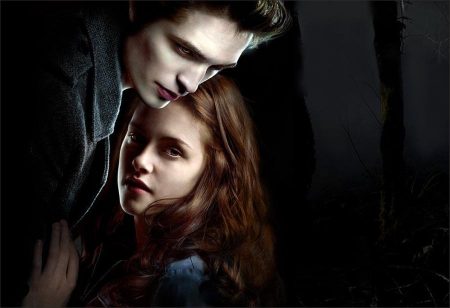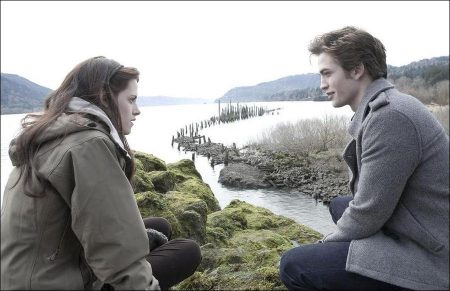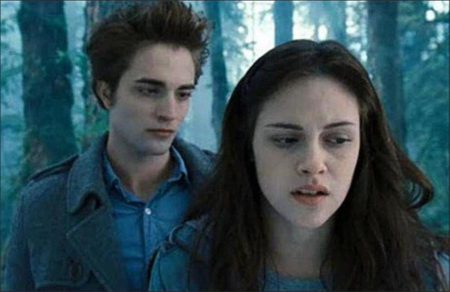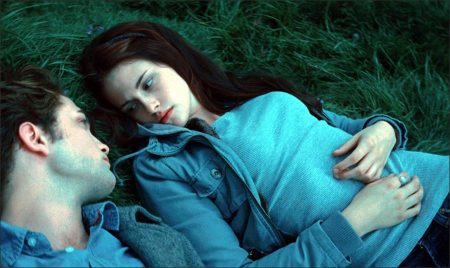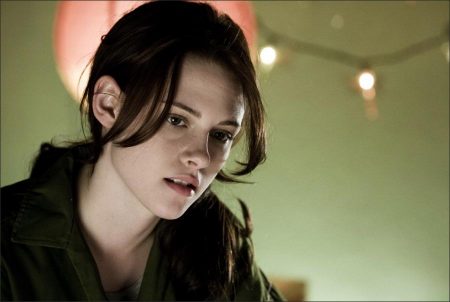Twilight Movie Trailer. Producer Greg Mooradian of Maverick Films first read Twilight before the young adult novel gained worldwide acclaim-in fact, before it had even been published. “Part of my job as a producer is to scour the world for new material,” says Mooradian. “I read a lot of manuscripts prior to their being published. When this one came across my desk, I just couldn’t put it down. The premise of a girl falling in love with a vampire just hit me like a ton of bricks. And the book delivered on every level.”
What drew Mooradian to the story was not its exoticism, but rather its universality. “There have been thousands of vampire films made,” he says. “What sets this apart is the love story. Vampirism in this story is simply a metaphor for teenage lust, for that feeling of ‘I want you, but I can’t have you.’ I thought that was such a wonderful metaphor to express teenage longing.
“It’s analogous to any young girl who has the opportunity to date the boy that her parents hope she’ll go out with,” Mooradian continues. “But then there’s that other boy who’s mysterious and dark and brooding, and there’s such a desire to unlock the secrets behind who and what he is, which in this case is a vampire. And that revelation happens at a point where she’s already too far in to withdraw, no matter what the consequences are.”
Twilight was the first published work by author Stephenie Meyer, who has gone on to create three additional books in the series, with no sign of slowing down. “As a first-time author, I had no idea what normal is,” she says. “I still don’t. I had no expectations. I was first approached about the movie before the book had even come out. I didn’t expect to hear anything about it until it was on the shelves, if then.”
Meyer describes herself as a mom first, then a writer, despite her chart-topping sales and prolific output. “For me, writing this book was so personal,” she says. “I was surprised that people responded to it so well. It still amazes me to watch how people get into the characters and how important it is to them. I get e-mails from people who feel like my book has actually changed their lives.”
A Brigham Young University graduate with a degree in English literature, Meyer says the idea for Twilight came from a dream. “When I woke up, I wanted to know happened next. That first day I wrote 10 pages. When I finished it, no one was more shocked than me that I had actually finished a book.”
As Meyer continued to add volumes to her narrative, Mooradian approached Summit Entertainment with the idea of developing the saga into a series of films. Twilight’s novel concept and compelling characters made it an apt candidate.
“The idea of a supernatural fantasy as background for a great tragic love story is a great combination,” says producer Wyck Godfrey. “Add to that a best-selling book series, and fans already connected to the characters, and we have a really good foundation to open it up to a new audience that may have never heard of Twilight. I think that once they see it, they’re going to respond in the same way as the people who have discovered the books.
“There’s a huge amount of danger in this movie,” Godfrey continues. “There’s also just the excitement of a teenager doing things that are verboten. These are things that people connect to. And not just girls-I think that guys will discover it’s dangerous, there’s action, there’s a thriller element to it, and then, ultimately, that it’s cool to be a vampire.”
As soon as she read the book, executive producer Karen Rosenfelt says she was immediately intrigued by the “Romeo and Juliet” aspect of the storyline as well as its sustained sexual tension. “I think we all think we’re Bella,” says the former Paramount Pictures production president. “As a character she’s very accessible and identifiable. We all feel outside of the in-group and want to feel we’re marching to the beat of our own drummer.”
Meyer was excited about the possibility of seeing her work translated to film, but only as long as the filmmakers remained true to the books. “All of us have seen books ruined as movies, and I had a lot of things that I wanted to protect. My stipulations were pretty basic: You can’t kill anyone who doesn’t die in the book. The Cullens have to all exist by their right names and in their right characters. Things like that. I wanted the groundwork to be there.”
The filmmakers were sensitive to her concerns and committed to remaining as faithful to the book as possible. “The book is a bible for so many young girls, we needed to tell the story as written, as much as possible,” says Mooradian. “Stephenie loved the script. But at the same time she had some very specific ideas, and we implemented nearly all of them, much to the benefit of the film. For example, we had slightly changed a passage from the book, ‘And so the lion fell in love with the lamb.” Stephanie suggested we go back to the way it was, because so many girls had tattooed that line on their ankles. I thought she was joking, but no.”
The producers tapped Catherine Hardwicke to direct the film. Hardwicke had segued a few years earlier from production designer working on films including Laurel Canyon, Vanilla Sky and Three Kings to writing and directing her debut film, the award-winning Thirteen, a sensitive and controversial look at a troubled teen’s relationship with her mother.
“By no means were we exclusively looking at female directors,’ says Mooradian. “But the core readership is young females, and we wanted to get somebody who understood that perspective. Catherine has really embraced that age group. She connects well with teenagers, and given her filmography, it was a natural fit. We did feel it was a plus for someone to be able to say that they’ve walked in the shoes of Bella, in terms of having that first crush on a guy, and that decision to go after the wrong guy, and the consequences that would come thereafter. We were fortunate to have found a great female director, as well as a great female writer to carry out the mission.”
Rosenfelt adds: “What Catherine demonstrated with Thirteen, Lords of Dogtown and The Nativity Story-all very different films-is that she can create a world that feels organic and not manufactured. That was really important in bringing Twilight to the screen.”
“When I read the book, I was swept away with the whole obsession-that ecstasy,” says Hardwicke. “Stephenie writes with such an authentic voice. Twilight had the potential to be so visual and cinematic and to capture that feeling: how it feels to be in love for the first time, and loving somebody so much that you’d literally be willing to turn into a vampire.”
Melissa Rosenberg came to the table with considerable experience writing for the film’s primary audience of high school age girls. In addition to the television shows “Party of Five” and “The O.C.,” Rosenberg wrote the screenplay for Step Up, an enormously successful teen romance between a ballerina and a street dancer, also for Summit Entertainment. She is currently a writer for the provocative Showtime drama “Dexter,” whose romantic hero is a serial killer. “Twilight is really the marriage of both my love of writing for teens and the sort of gothic-ness of horror,” she says. “When they called me, all they had to say was teens and vampires and I was there.”
The book’s devoted following put a great deal of pressure to remain true to its spirit, says Rosenberg. “Knowing how important the story is to millions of fans, and how personally they take it, I knew we had to stay very close to the book to win them over. It is a gift to be given such rich source material. I had no intention of ever going anywhere other than the world of the book.
“Twilight is a romance between a girl and the ultimate unavailable boy-a vampire,” adds Rosenberg. “The enormous obstacle is he could kill her at any moment. I loved the chemistry between Bella and Edward. That pull is a very universal experience. Anyone who has been a 17-year-old girl knows what it’s like to see that wonderfully mysterious and unavailable boy across the room and just feel that longing. The book takes that universal experience to the next level of the fantasy playing out. If I only ever write for teenage girls, I’ll be perfectly happy, because when they love something, they embrace it with all of their heart. It’s a great audience to write for.”
The Life of a Vampire
From the earliest meetings, costume designer Wendy Chuck had a strong vision for the Cullens’ wardrobe. “In the book, the Cullens are described as having immaculate taste,” she says. “Making them look different, but still able to blend with the people in Forks was a challenge in itself.”
Meyer was happy with the direction the filmmakers took in terms of her characters’ clothes. “A lot of people think because you’re dealing with vampires, we’re talking about floor length leather dusters in black and chokers and whatnot and I knew that was going to be a temptation,” says the author. “Catherine was able to say no to that. We talked about light colors and classic designers and things like that.”
When Chuck first met with Hardwicke, she pitched some ideas that corresponded with what the director was already thinking. “I just thought, we’ve seen all that before-the Goth look, the black and the bondage look. Let’s have something different for a change. I kept coming back to the idea that a vampire world was one that was caught in time. It was glacial; it was a frozen moment for them. To me it became about reflections and transparencies and white and silver and grey, with highlights of black or a contrast color to use like blue. That’s where our palette started and I presented Catherine with some tear sheets. There was one in particular she liked and we thought, ‘Oh, those are colors of an Arctic wolf.’ We used that as the theme for creating the Cullens’ world.”
Starting with the idea of vampire as rock star, Chuck began to make slight differentiations in the characters, based on their backgrounds. “Edward is from the Edwardian Era and he wears boots that lace up, trim pants and some really classical shapes and styles of the time. Alice is supposed to be a pixie. I couldn’t help but refer in my mind to Alice in Wonderland. She was easier to dress only because of who Ashley is and how great she looks in clothes.
“Bella’s style was evolutionary. As she becomes more entwined with Edward and the Cullens, she starts to wear more blue.”
The nomadic vampires had their own, edgier style of dressing, based on the idea of taking trophies. “We made James the very feral one,” says Chuck. “You’ll notice that his leather jacket has embellishments of badges and other stuff. He’s a killer, and he does it for sport. So he collects these things and he wears them with pride. Rachelle is just so beautiful and perfect for the part of Victoria. We decided that she would have some kind of animal item on her but we didn’t want to do leather. Fur didn’t seem right and then this sheep’s skin came into play and so I rigged it in a way that she could wear it in different ways. Then she’s got her hardcore rock star jeans.”
“James and Victoria have all these trinkets, all these shiny things that we pick up that clearly belonged to other people,” says Lefevre. “I’ve got this bracelet that initially looks like I took it from a little old lady, but upon closer inspection, it looks more like the kind of thing you would give a little girl. We’re full of knickknacks.”
Stephenie Meyer selected Forks, Washington, as Bella’s hometown after a web search for the rainiest places in the continental United States. It was essential that the Cullens settle in a location that rarely sees direct sunlight, because the sun reveals the Cullens as something other than human. An exhaustive search for the perfect location to replicate the dank, dark and moody community took the filmmakers to Oregon, where weather conditions mirrored those of Forks and the filmmaking community was strong.
“One of things that was so great for us was that the setting for the film became a character in its own right,” says Hardwicke. “In this case, the rainforest of the Olympic Peninsula, a diverse blend of climates and natural wonders, is iconic in the film; the moss and the dripping trees, where the Cullens live-which almost feels like a very cool tree house-and the constant, persistent mist and rain.”
The 48-day production turned out to be more arduous than the producers expected. “The shoot was really difficult from a physical perspective,” says Mooradian. “Oregon had all these great locations, but they weren’t always right beside a parking lot .We often had to go deep into the woods and take all of our equipment in there. You’ve got to be able to create optimal lighting conditions. That aspect of it was very, very difficult-plus we had crazy weather in Portland, where the weather changes four times before lunch. And when you’re shooting exteriors that can be a great challenge.”
Immaculately outfitted and ensconced in the gloomy Northwest, the actors needed only a little help with their vampire superpowers to complete the transition. Twilight is packed with astonishing stunts designed by second unit director and stunt coordinator Andy Cheng. According to Cheng, the most effective way to stage the extraordinarily acrobatic super-powers possessed by the vampires was through wirework. “Throughout the preparation period, and even during filming, Catherine and I had many discussions about how we would depict the physicality of the vampires. We agreed that they could move really fast when they run, but not at lightning speed. They can jump really far, so their movements are more catlike than anything. Wirework helps tremendously and CGI refines the ragged edges.”
Producer Godfrey says of Cheng, “He is the right tool for this job. He’s the best. He knows how the rigs work and what you can realistically accomplish. He brings a lot of energy to everything he does, and I think that was important for Catherine. She is somebody who likes to focus on performance and relationships and the love story, so to have somebody she trusted and believed in to give us some of the extraordinary action of the movie was invaluable.”
To allow the actors to appear to be running at super-human speed, Cheng used what he calls the Magic Carpet Ride. “The Magic Carpet Ride is a stunt rig that is pulled along the ground and when you’re shooting people long-lens or beside them, even if they’re running or walking, all you’re seeing is their relationship to the background. So, when you’re watching the characters walking on it, it looks like their flying across screen, which gives it a supernatural feel.”
Twilight (2008)
Starring: Kristen Stewart, Robert Pattinson, Justin Chon, Anna Kendrick, Rachelle Lefevre, Nikki Reed, Cam Cigandet, Michael Welch, Peter Facinelli, Christian Serratos, Ashley Greene
Directed by: Catherine Hardwicke
Screenplay by: Melissa Rosenberg
Cinematography by: Elliot Davis
Film Editing by: Nancy Richardson
Costume Design by: Wendy Chuck
Set Decoration by: Gene Serdena
Art Direction by: Christopher Brown, Ian Phillips
Music by: Carter Burwell
MPAA Rating: PG-13 for some violence and a scene of sensuality.
Distributed by: Summit Entertainment
Release Date: November 21, 2008
Views: 174
